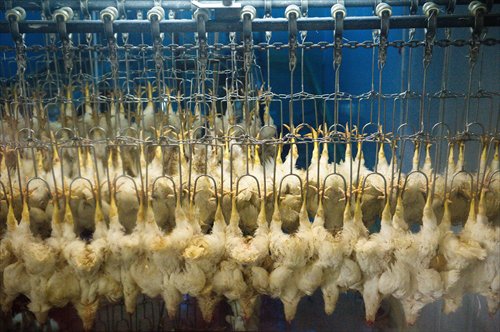US files new chicken complaint against China
Nation will act in line with WTO rules: MOFCOM

Chickens in a factory in Nanping, East China's Fujian Province Photo: IC
China regrets a decision by the US to launch a complaint with the WTO about Chinese anti-dumping tariffs on US poultry products, but will resolve the dispute in line with WTO procedures, the Ministry of Commerce (MOFCOM) said in a statement posted late Tuesday on its website.
China respects and has acted in accordance with the WTO on the case, MOFCOM said in the statement.
The statement came after the US on Tuesday filed a trade complaint against China's anti-dumping duties on US broiler chicken products, making it the latest case of tension in US economic ties with China.
The US is asking China to open its market to US chicken, especially the chicken feet enjoyed in Asia, or face potential trade sanctions, the Wall Street Journal reported on Wednesday.
China's anti-dumping and countervailing duties violate WTO rules, partly because China failed to properly calculate US poultry production costs, Reuters reported, citing the US Trade Representative's office.
The complaint is the second US WTO objection to China's 2010 imposition of anti-dumping duties as high as 105.4 percent and countervailing duties of up to 30.3 percent on US broiler chicken products, media reports noted.
Back in 2009, MOFCOM conducted probes into broiler chicken imports from the US and found out that there was evidence of both subsidies and dumping by the US side, Guo Huiyong, a Beijing-based industry analyst, told the Global Times on Wednesday.
"Tuesday's complaint from the US is a continuation of the case," Guo said. "It is a dispute within the industry and cannot be seen as something related to a trade war between the two countries," he noted.
"In fact, the prices of some agricultural products imported from the US are quite low," Ma Wenfeng, a senior analyst at Beijing Orient Agribusiness Consultants, told the Global Times Wednesday.
Import imbalance
Trade frictions over poultry products between China and the US started in 2004 when bird flu emerged and both countries halted poultry imports from each other.
"But after that period, the US kept its market closed to Chinese poultry products while exporting its poultry products to the Chinese market," Guo said. "This kind of imbalance is unfair."
Domestic demand for chicken imports is substantial and about 90 percent of the imports came from the US before China's imposition of duties on US broiler chicken products, experts said, noting that China mainly imports products such as chicken wings and feet from the US.
The US exported just 6,804 tons of chicken, turkey and eggs to China in 2015, compared with 330,669 tons in 2009, before the tariffs on US chicken took effect, news.morningstar.com said Tuesday, citing data from the US Department of Agriculture.
After the WTO accepted US claims about China's violation of WTO rules on August 2013, China re-examined the situation and cut the tariffs on US broiler chickens in July 2014, MOFCOM said.
China now levies anti-dumping duties up to 73.3 percent and anti-subsidy duties up to 4.2 percent, according to media reports.
Domestic companies were not affected that much by the WTO's decision because chicken imports from the US declined after the tariff imposition in 2010 and China began to increase imports from countries in Latin America such as Argentina and Brazil, according to Ma.
Inventory cut
Chinese companies that produce broiler chicken products started to expand in 2013, but the industry has been reporting losses in recent years amid China's slower economic growth, experts said.
Production of broiler chickens reached 10 million tons in 2014, domestic market research firm chinabgao.com said in July 2015, citing industry data. And the inventory of unsold poultry products stood at 600,000 tons to 700,000 tons in the domestic market during the same period, said the report.
"The country's chicken industry has a large inventory of unsold products. It has been and will make efforts to cut the inventory, but the results have not been obvious yet," said Guo, the industry analyst.